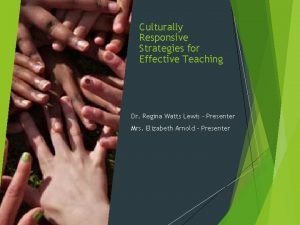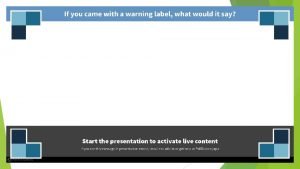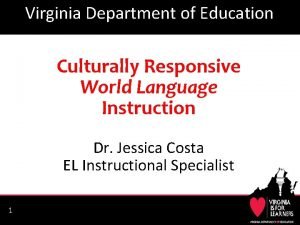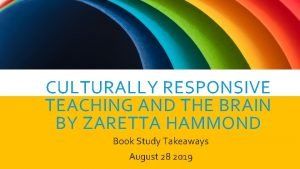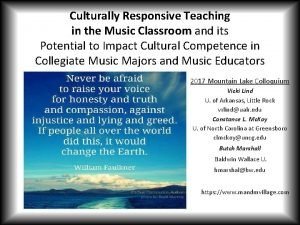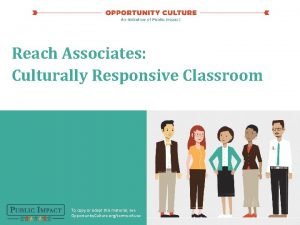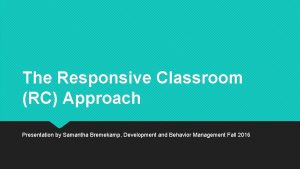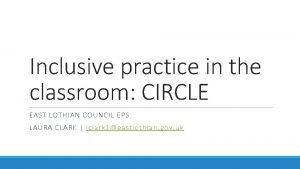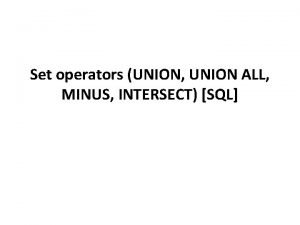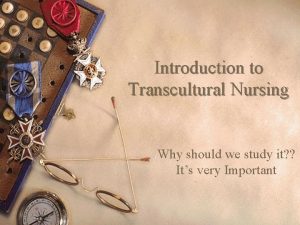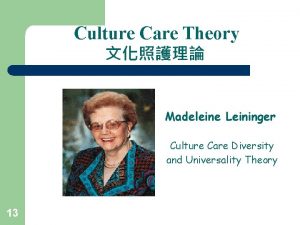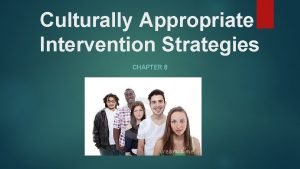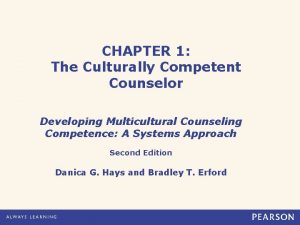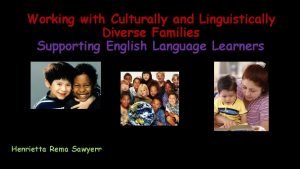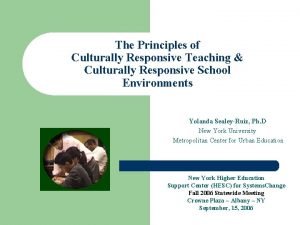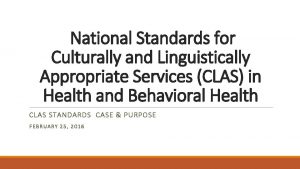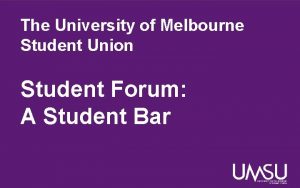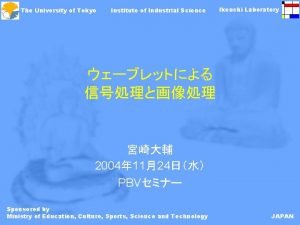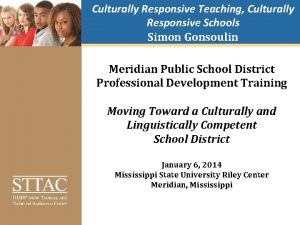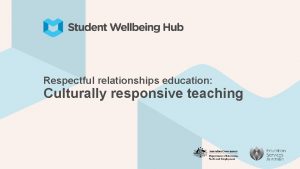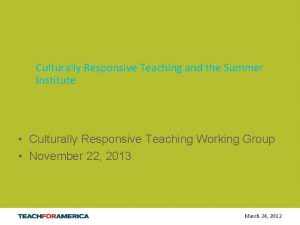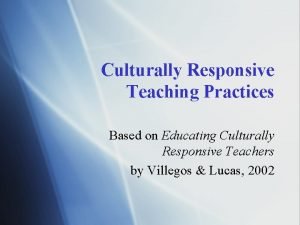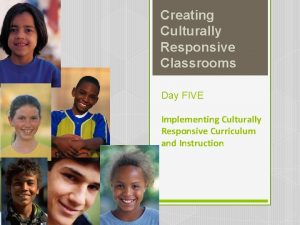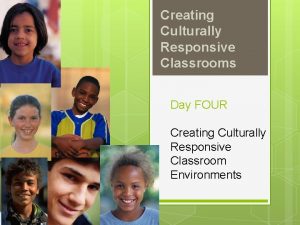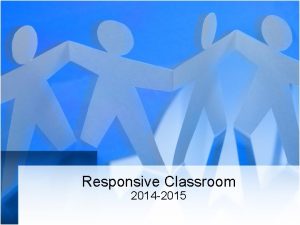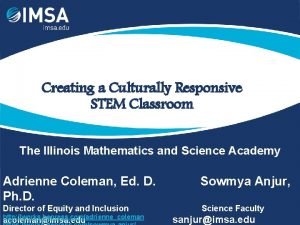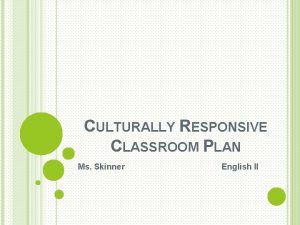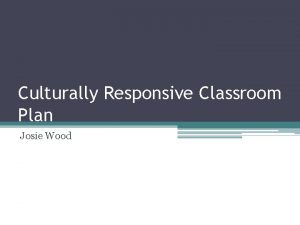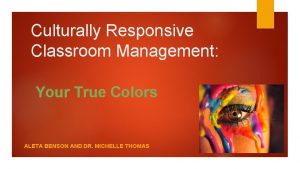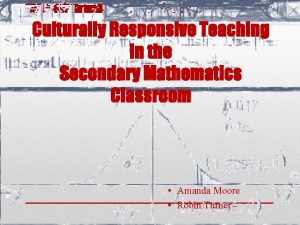THE CULTURALLY INCLUSIVE RESPONSIVE CLASSROOM Union Institute University



















- Slides: 19

THE CULTURALLY INCLUSIVE & RESPONSIVE CLASSROOM Union Institute & University Spring /Summer Virtual National Faculty Meeting May 28, 2015

WHY IS THIS IMPORTANT? Union Institute & University’s Vision § Diversity – Union Institute & University reflects and celebrates diversity in all its forms Higher Learning Commission (HLC) Criterion Three – § Teaching and Learning: Quality, Resources, and Support 3. B. 4 “The education offered by the institution recognizes the human and cultural diversity of the world in which the student lives and works” Globalization § Student body § Alumni base § Employer needs

WHY CREATE AN INCLUSIVE ENVIRONMENT? Student Engagement and Retention § “When academic knowledge and skills are situated within the lived experiences and frames of reference of students, they are more personally meaningful, have higher interest appeal, and are learned more easily and thoroughly. ” (Gay, 2001 pg. 106) § Students tend to stay when they feel connected to the college and the faculty. (Tinto, 1993)

THE BIG FIVE 1. Developing a knowledge base about cultural diversity 2. Including ethnic and cultural diversity content in the curriculum 3. Demonstrating caring and building learning communities 4. Communicating with ethnically diverse students 5. Responding to ethnic diversity in delivery and instruction (Gay, 2001)

CULTURE The customary beliefs, social forms, and material traits of a racial, religious or social group (Merriam Webster, 1993) Social Group: Working Adult Student

EXPANDING THE DEFINITION Race Ethnicity Socio-economic class Gender Sexual Orientation Marital/Family Status/Structure Language Age Religion Political Affiliation Educational Background Others?

THE WHOLE PERSON Instructor and Student Racial/Ethnic Educational Background Age Political Affiliation Gender Student Sexual Orientation Religion Socio. Economic Status Marital /Family Status

ACTION STEPS Preparing Yourself … Before Course Begins Preparing the Students … During the Course Reflection … After the Course Ends

BEFORE COURSE BEGINS Self-Exploration § Di. Pietro’s “Checklist of Assumptions” – Experience and Knowledge § Gay’s Develop a “Cultural Knowledge Base” - Learn what you don’t know Curriculum/Course Design § Di. Pietro’s “Checklist of Assumptions” – Experience and Knowledge/Identity and Viewpoint § Gay’s Designing Culturally Relevant Curricula – What materials do you use and why? What are your goals and objectives for the course? Building Your Classroom § Gay’s “Building a Learning Community” – How can you help students to be successful?

DURING THE COURSE How do you create an environment where students feel like they can be successful? § Cultural Scaffolding – Incorporate the “world of the student” into the curriculum/syllabus. Help them make the connection between their real lived experiences and the content. § Communication – Check in with students to make sure that they understand the language that is being used in the classroom. Check in to make sure that they understand the context of the materials being discussed. § Cultural Congruity – “Match” how people learn/study/process information with what goes on in the classroom (on-ground, online [synchronous/asynchronous]).

THE ONLINE ENVIRONMENT Example of Building a Learning Community § Faculty Bio/Welcome § What information do you disclose about your identity? § What information do you include to connect with the students? § Student bios or introductions § § Is there a template? What categories of information is in it? Is a picture option available/required? What do you need to know about a student? What do his/her (or gender neutral pronoun) peers need to know? § Introducing New Information/Topics to Students § Research the authors § “Bring in” related information that relevant to you (this helps build community and curriculum)

THE ONLINE ENVIRONMENT Culturally Diverse Curriculum § “Preparing for Culturally Responsive Teaching” (2002 article by Dr. Geneva Gay) § “Checklist of Assumptions that Can Impact Motivation, Learning, and Performance” (2007 White paper by Dr. Michele Di. Pietro)

SOMETHING TO THINK ABOUT Communication Styles and Introduction to Criminal Law § Concept: Topic-Centered and Topic-Chaining In a course on criminal law, the main objective is to teach students the fundamental concepts in criminal law. This is mostly done via case study. In many of the cases read, most of the defendants are African American and Hispanic. Why is the case? Is it because most of the defendants are in fact African American and Hispanic? Is it because most of the cases from which United State Supreme Court landmark decisions are made involve injustices perpetrated against African Americans and Hispanics?

SOMETHING TO THINK ABOUT What are thoughts of the students? How are they processing the information? What are their responses? What is the affect of this process on their ability to complete the assigned work? What are thoughts of the instructor? How is s/he processing the information? What is the affect of this process on his/her ability to provide feedback and assess student learning? Should these questions be discussed at all if the objective is to learn criminal law and the fundamentals of the criminal justice system?

CROSS-CULTURAL COMMUNICATIONS Ex/ Student wants to know why officers did not take the time to read Miranda rights in a language that could be understood by the person being arrested. Police didn’t have Spanish speaking officers onsite Student: Why wouldn’t a community that is home to many Spanish speaking people not have several Spanish speaking officers? Teacher: That’s not the main issue that we’re discussing or the main point. Student: But the whole thing doesn’t make sense within the context of what happens in real life. Or the needs of the community.

AFTER THE COURSE Review/Assess Performance …Self-Reflection § § § Were there any communication issues? How did students respond to assignments? How did students perform? How did you respond to students questions? Did you perceive that any students challenged your knowledge base? What were the challenges about? § Content, process § Prior knowledge or background information § The importance or relevance of assignments and readings § What assumptions did you make that may have influenced all of the above? (Di. Pietro)

REFERENCES Di. Pietro, M. (2007). Checklist of assumptions that can impact motivation, learning and performance. Eberly Center for Teaching Excellence, Carnegie Mellon University. Gay, G. (March/April 2002). Preparing for Culturally Responsive in Teaching in Journal of Teacher Education, Vol. 53, No. 2. pp. 106 -116. Tinto, V. (1993) Leaving College: Rethinking the Causes and Cures of Student Attrition. University of Chicago Press: Chicago

ADDITIONAL RESOURCES Banks, C. A. and Banks, J. A. (Summer, 1995). Equity Pedagogy: An Essential Component of Multicultural Education. Theory into Practice, Vol. 34, No. 3, Culturally Relevant Teaching (Summer, 1995), pp. 152 -158. http: //www. unco. edu/cebs/diversity/pdfs/Banks_Equity%20 P edagogy_An%20 Essential%20 Component%20 of%20 Multicultur al%20 Education. pdf Sleeter, C. E. (2001). Cultural, Difference and Power. Teachers College Press: New York. http: //www. teacherscollegepress. com/culture. pdf http: //itspronouncedmetrosexual. com/

THANK YOU & CONTACT INFORMATION Special thanks to Dr. Nelson E. Soto, Vice President for Academic Affairs Mr. Wes Jackson, Project Coordinator, Office of the Vice President for Academic Affairs Mary Amos, Senior Academic Technologist and Designer Contact: Tuesday L. Cooper, J. D. , Ed. D. Email: tuesdaycooper@gmail, com
 Culturally responsive vs culturally relevant
Culturally responsive vs culturally relevant Classroom
Classroom Vdoe culturally responsive teaching
Vdoe culturally responsive teaching Culturally responsive teaching and the brain slides
Culturally responsive teaching and the brain slides Culturally responsive teaching in music education
Culturally responsive teaching in music education Reach associates
Reach associates Responsive classroom youtube
Responsive classroom youtube Circle participation scale
Circle participation scale Sql union minus intersect
Sql union minus intersect Culturally deprived definition
Culturally deprived definition Certified transcultural nurse
Certified transcultural nurse Leininger
Leininger Culturally appropriate intervention strategies
Culturally appropriate intervention strategies Culturally competent counselor
Culturally competent counselor Working with culturally and linguistically diverse families
Working with culturally and linguistically diverse families Pedagogy meaning
Pedagogy meaning National culturally and linguistically appropriate services
National culturally and linguistically appropriate services Btech smart classes
Btech smart classes University of melbourne student union
University of melbourne student union Institute of industrial science the university of tokyo
Institute of industrial science the university of tokyo
